By Jeffrey A. Rendall, Photos By Jeff Janas
BLUFFTON, SC -- It takes guts to blaze a trail into the unknown. I've often wondered what it felt like to be the first human beings to set sail across an ocean; or the first person to jump out of an airplane, or even the first man to walk on the moon. It takes a certain kind of daring mindset to try something different, and then make it work.
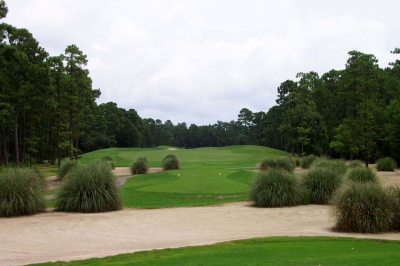 |
Though it's hardly a fair comparison to claim leaving an island for the mainland takes the same kind of intestinal fortitude, when you're leaving the golf Mecca that is Hilton Head Island to move inland to a town called Bluffton, it's a big step. Not really a small step for man -- or even a giant leap for mankind, but a risky business decision at the very least.
That's exactly what they did when dreaming up Hilton Head National, which today features 27 holes of great golf that's only a short distance from Hilton Head Island but miles away from conventional wisdom. The original 18 hole Gary Player design was the first public track in the area to stray from the cozy confines of the island, with no assurances the destination's lucrative tourist industry would follow it over the bridge.
Eleven years later, the experiment's a most decided success. A third nine was added in 1998 (the Bobby Weed nine), and last year Hilton Head National came within a few hundred of its yearly rounds goal of 60,000. And according to National's General Manager, Shannon Archer, this year they'll make it.
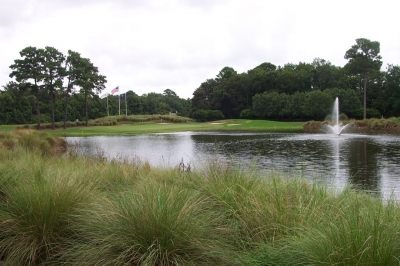 |
Archer adds: "We knew, being the first public course off the island, that we'd need to do the little things well in order to get folks to come over and play it. And I think we've developed a good formula for doing that. Not only do we have 27 holes of great golf by Gary Player and Bobby Weed, but we have superior conditioning and value that may not always be found on the other side of the water."
That's not the only thing that's different on the mainland side. Trees and wetlands, not houses and condos border Hilton Head National's fairways and greens. Though I'd never claim that playing golf surrounded by houses ruins the experience, it is nice to be out there on occasion with just yourself and nature. Hilton Head National provides that sense of isolation that you won't get at most other island courses. It feels more like a country club than a resort course -- another distinguishing feature.
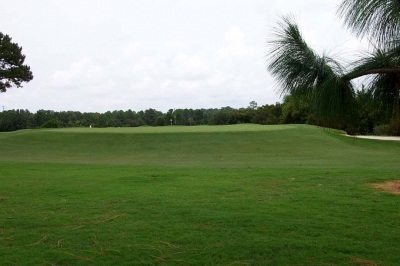 |
The layout itself is also somewhat different than many other low country tracks, with its player friendly attributes. Its four (sometimes five) sets of tees allows you the option to choose the right yardage for you -- and the course is designed to toughen incrementally according to how far back you want to push it (which, in fairness, is true of most courses, Hilton Head or otherwise). The forward sets take many of the forced carries out of the picture, so you'll spend less time gathering insect bites in the weeds and more time playing golf on the course.
Player wanted it that way. He designed Hilton Head National to serve as a straightforward test of golf, easy on the high handicapper but challenging for the better player. You'll have run-up opportunities on most every hole, and hazards won't clog your line of sight. Visual intimidation isn't included on this course.
Continuing on the playability theme are the greens. The putting surfaces are large and only mildly undulating. The toughest thing about them is figuring out the grain of the Bermuda grass -- but you'll find that everywhere in the region. At least Player grants some leeway with the green slopes -- garner the correct read on the grain, and you're set to putt it straight most of the time.
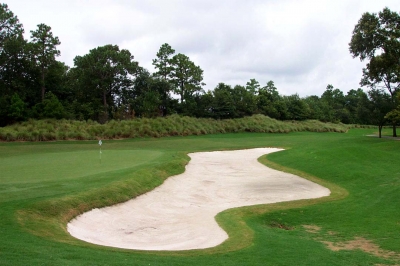 |
The service is also excellent. Archer says Hilton Head National's staff is larger than usual for a golf course, with the idea that what you lose in payroll is made up in customer satisfaction. Sure enough, you won't want for friendly advice, on-course beverage service or directions to the first tee. "We want people to feel like they're 'members for a day,'" Archer adds.
Finally, a note on conditioning. Hilton Head National prides itself on course conditioning -- and it shows. The fairways are lush, the rough is thick (don't know if that's good or bad!) and the greens are in great shape for a course that receives such heavy play. The only demerit in this regard stems from a few of the tee boxes -- but it's obvious that a great deal of TLC goes into maintaining the layout as a whole.
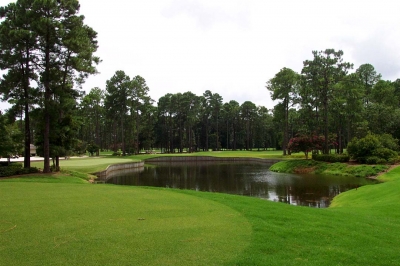 |
We played the original eighteen holes designed by Gary Player -- known as the National and Player nines, in the order they originally were numbered, one to eighteen. Player eases you into the round with a reasonably tame par four, straight on and 364 yards. A single bunker guards against a tee shot long and left, but the fairway's wide -- with plenty of room to miss right. Slicer's paradise.
Number five's a slight dogleg right with a tee ball over a lake and ample fairway to shoot at. A large waste area guards the right side on the approach, more for aesthetics than influence in play -- though it will catch anything dramatically short and right of the green.
Seven's a tough 547 yard par five, the National nine's #1 handicap hole. Woods encroach the fairway on both sides, but it looks narrower than it is. The hole doglegs slightly to the left, making any thoughts of trying it in two unrealistic, though the green is certainly receptive to a run-up shot. A large oak guards the left side of the green -- something to consider if you choose the layup option.
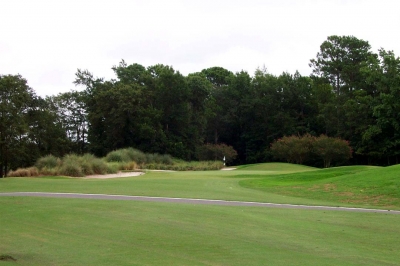 |
Nine's a great hole. 440 yards from the tips, the tee shot from the back tee box demands a 175 yard carry over wetlands, which also guard the right side. Archer says if the hole's playing into the wind, as it typically does in the fall, even a good drive will leave 220 yards into a large plateau double green, with the 'Valley of Sin' lying in between the National and Player nines' ninth holes. If you're short, a tricky pitch awaits -- up onto the tabletop green.
Moving to the Player nine, particular favorites were number four, six, eight and nine. Four is a challenging 195 yard par three with nearly a full water carry from the back tees. A bunker left will protect you from the water if you're pin high, and a grass bunker awaits on the other side. Short right's the best miss option.
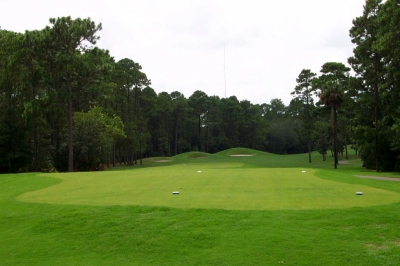 |
Six is another thoughtful par five, only 505 yards in length but a steep dogleg right that won't allow for much distance to be cut. The second shot's all risk-reward, as a pond fronts the green -- and you'll need at least a 210 yard carry to fly it. Trees border the narrow green on both sides -- making it a narrow looking chute to blow it through. This is one hole where you'll actually be lucky to hit a short tee ball, mandating a layup. Fate decides for you on that occasion -- probably wisely, too.
Eight is a great visual par three -- the one you can see from highway 278 as you pass by the golf course. Seven tee boxes present seven distinct challenges to hit the green -- and calling for a full water carry to reach it -- the longest measuring 175 yards. Grab your water ball and take a shot -- but the target's fairly large if you make the carry. Block out the water! Four bunkers await long if you take too much club.
Like the National nine, the Player nine has a great finishing hole. Hookers (in the golf sense) beware as there're wetlands down the entire length to the left, but a wide fairway will most likely present a chance to get home in two. Unlike the sixth, there's a generous runup option on this hole, so pull out the fairway metal and have a go at it. The green is large -- so large in fact, you're in three-putt territory on much of it (or maybe it just looks that way because it's a shared double green with the National's ninth hole).
All in all, you'll be glad that the Hilton Head Island area now offers great golf on the mainland, and that the people who built Hilton Head National led the way. You'll find great conditions, good service and fair challenge on this Player/Weed designed complex. And it might even inspire you to blaze a few trails yourself.
Details:
Hilton Head National
Phone: (843) 842-5900
FAX: (843) 837-5502
Website: www.golfhiltonheadnational.com
General Manager: Shannon Archer
Course Architects: Gary Player -- 18; Bobby Weed - 9
|
|
Yardage/Slope (back tees) |
|
National-Player |
7200/128 |
|
Player-Weed |
7170/132 |
|
Weed-National |
7150/125 |
Rates (seven days a week):
Off Season (Winter and Summer): $45 - $65
High Season (Spring and Fall): $65 - 105, March through May.
| Related Links | Comments on this article? | |
|
Maryland National Golf Club Hollow Creek Golf Club Rocky Gap Resort PB Dye Golf Club in Ijamsville Whiskey Creek Golf Club |
E-mail Jeff Rendall, Editor: jrendall@golftheunitedstates.com |











